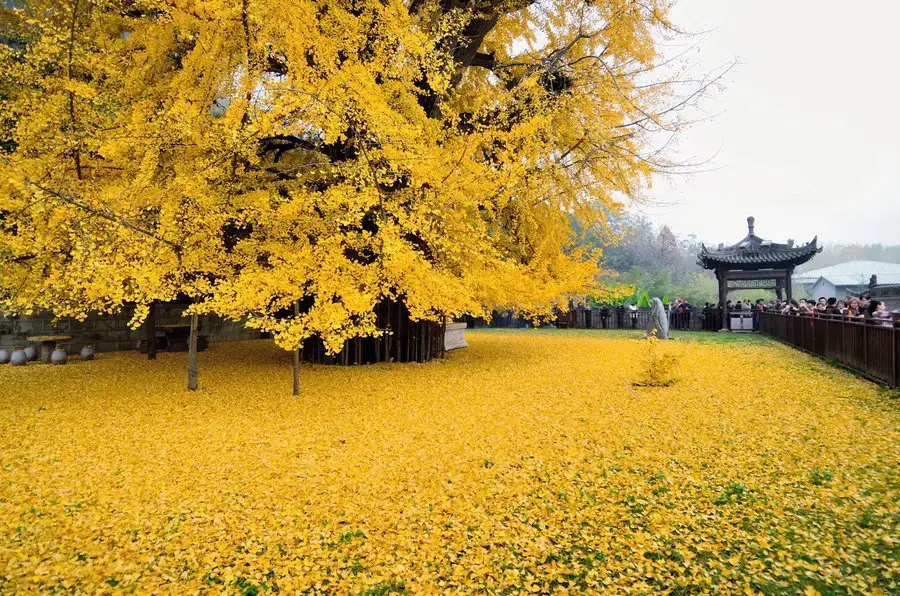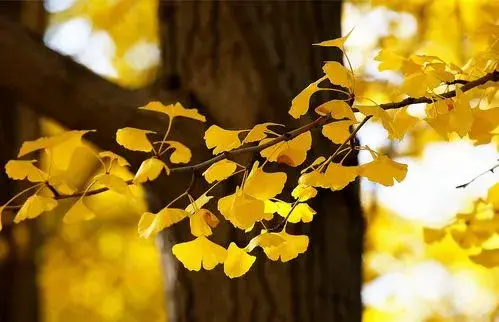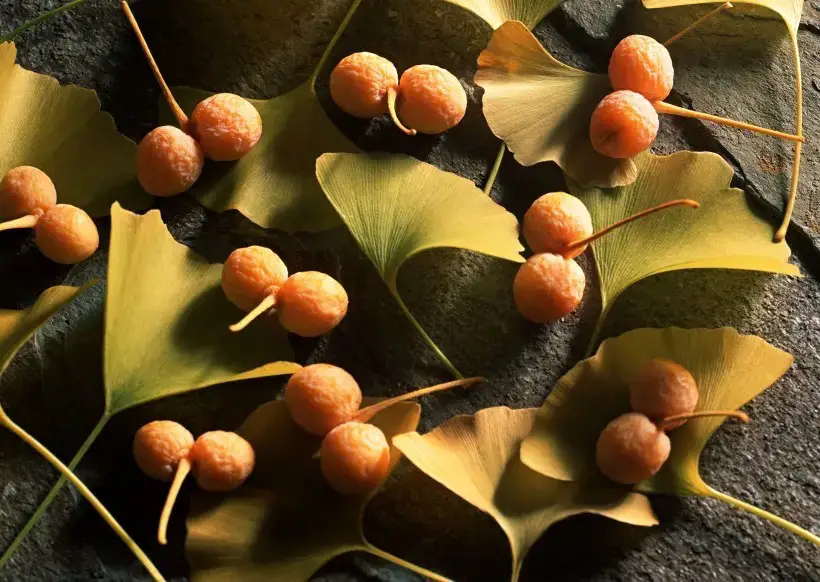Ginkgo biloba is also identified as the Maidenhair tree in the West due to its leaves’ resemblance to those of the common maidenhair fern and is a tree native to China. When young, the tree has a cone-like shape, but as it grows older, it takes on an irregular, rounded shape with spreading branches. Ginkgo leaves are distinctive, and triangular with a central groove in the center of the leaf blade. The leaves are light to medium green in the summer and turn yellow in the autumn before falling off in the winter. A ginkgo tree can reach heights of 80 feet and widths of 40 feet. Many people consider Ginkgo biloba trees to be living fossils, having remained almost unchanged for over an estimated 200 million years.
Where do Ginkgo trees come from
Botanists concur that ginkgo is native to China, specifically the Zhejiang province’s remote mountain valleys. This tree was thought to have died out until a sample was found in Japan in the 17th century after being brought there from China in the 13th century and grown in Buddhist monasteries. Some specimens were also found growing in the countryside in Jie Ziang province’s northwest. Ginkgo seeds were brought to Europe during the 17th century and have since been cultivated as specimen trees in many parts of the world.
Types of Ginkgo trees

Ginkgo biloba is the only known surviving plant species of the family Ginkgoaceae. Just like conifers and cycads, ginkgo is a gymnosperm, a non-flowering plant.
Currently, three types of ginkgo cultivars exist. These are columnar or Fastigiata, wide-canopy, and dwarf ginkgo trees.
Examples of Fastigiata cultivars include Princeton, Fairmont, Upright Maidenhair, Golden Colonnade, Magyar, and the female Liberty Splendor Maidenhair Tree.
Wide canopy cultivars are ginkgo trees such as the Autumn Gold, Santa Cruz, Presidential Gold, Golden Globe, Shangri-La, Samurai, Menhir, Elmwood, and the Kohout Weeping Maidenhair Tree.
Dwarf cultivars of ginkgo trees are smaller and slower-growing, so you can keep them as shrubs. They include Jade Butterflies, Mariken, Spring Grove, Chase Manhattan, Potter Pete, the Mutant Weeper (Weeping Wonder), Boleslaw Chrobry, and the Majestic Butterfly Maidenhair tree.
How old do Ginkgo trees get
Ginkgo trees are known to live very long lives. Some specimens are said to be more than 3,000 years old. One explanation given for their incredibly long lifespans is their remarkable resistance to pests and disease.
The other is in how they age. The plants grow up and out: Up, in the apical meristem, and out, with the vascular cambium. Weather and other factors destroy the apical meristem over time, limiting a tree’s height. However, the cambium, which is contained within the tree’s trunk, remains undamaged and active. This causes ginkgo to spread indefinitely. Although the rate of width growth slows down with age, it does not stop, so the tree can keep renewing and replacing dead cells. The reason given for the behavior is in the ginkgo cambium genes, which they say contain no program for aging or death. Their program for making defenses continues to work even after hundreds of years.
What are Ginkgo trees good for
Ginkgo trees are good for urban landscaping. This is because they are tolerant of cold, salt spray, drought, heat, pollution, and compacted soils, making them popular urban street trees. The male ginkgo trees are preferred for this purpose, as they do not produce messy and repulsive fruits.
People also love the flow of yellow leaves that the tree has in the fall. Ginkgo trees turn golden all at once, making a spectacular display.
While the average urban tree has a life expectancy of about 10 years due to pollution, ginkgo trees survive much longer.
What are ginkgo trees used for

Ginkgo trees are primarily used in many parts of the world as ornamental and landscaping trees. City planners use male-only trees, as the females produce unsightly, smelly fruits.
In Chinese tradition, ginkgo trees are favored for their production of leaves and seeds that have many medicinal uses, primarily for blood flow and circulation. Ginkgo is also used to dry up damp, stagnant conditions, expel mucus, and open up the lungs. It is noteworthy that Chinese medicine does not use ginkgo continuously, and it is always cooked in a meal if possible.
Early Taoist shamans would carve spells on ginkgo trees to communicate with the spirit world.
In modern herbal medicine, ginkgo tree leaves are used to treat a myriad of conditions. They produce a substance called ginkgolide, which is said to improve blood flow and circulation and has anti-inflammatory properties. Ginkgolide levels peak in the fall when fruits appear on the female tree.
For its ability to improve blood flow and circulation, ginkgo is used to improve vision and treat dementia, memory impairments, Alzheimer’s disease, and tinnitus. For its ability to boost the anti-inflammatory function of the body, ginkgo is used to manage depression, reduce asthma flare-ups, and increase lung capacity.
Ginkgo symbolism China
The Ginkgo biloba tree is the Chinese national tree. For hundreds of years, the ginkgo tree has been a sign of hope and peace in China. This representation can be found throughout Chinese literature and art. Ginkgo is even depicted as a symbol of hope and peace on a wall painting in an ancient tomb.
What does the Ginkgo leaf represent

The ginkgo leaf is known as “the Buddha’s fingernail.” This is due to the fan-shaped leaves, which are said to represent joy and ever-expanding fortune, as well as for Buddhist monks’ devotion to the care and reproduction of these trees of old. The Buddhist monks’ cultivation of ginkgo trees was a significant factor in the trees’ survival.
Because of its symbolism, the Ginkgo leaf has become the symbol of Japan’s Urasenke tea school.
Ginkgo Biloba symbolism
Ginkgo biloba is particularly important in Chinese, Korean, and Japanese cultures. Ginkgo trees are revered by religions in these three countries as sacred trees and a symbol of resilience, and because they can live for thousands of years, they are thought to signify longevity and good health. Ginkgo biloba is also a cultural icon associated with fertility and hope.
Although ginkgo is the Chinese national tree, it has a special place in Japanese tradition and recent history. Its distinctive fan-shaped leaf carries the symbolism of ever-growing fortune with its singular beauty, but more than that, it signifies profound endurance since four Ginkgo Biloba trees survived the Hiroshima nuclear blast in 1945 and thrive to this date.
Conclusion
Ginkgo trees form an important part of our earth, which needs to be conserved, as it is likely that we have not yet discovered all that they can contribute to life on earth. There are no known Ginkgo biloba wild trees. Every one of them growing today has been propagated or otherwise taken care of by humans. When selecting, we should remember to cultivate both male and female ginkgo trees since the species needs both sexes to reproduce.